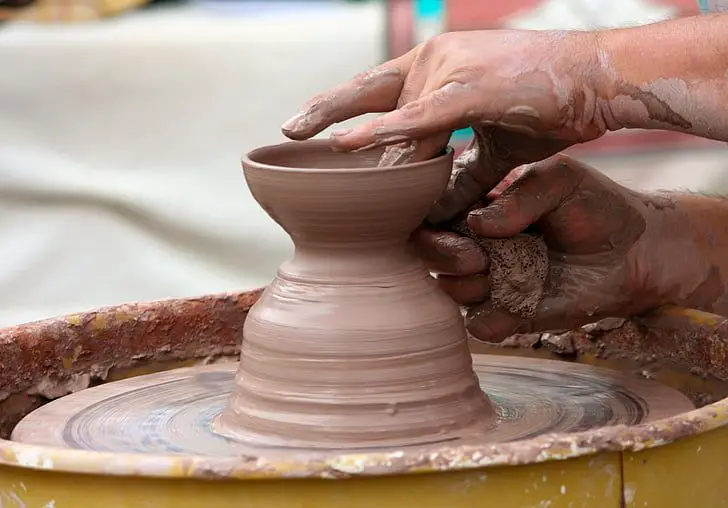Which Mexican City Is Known For Its Vibrant Pottery And Ceramics Industry?
Introducing the Famous Pottery City
The city of Puebla, located in central Mexico, is renowned worldwide for its longstanding tradition of pottery and ceramics production. With a history stretching back over 500 years, Puebla has developed a signature style of Talavera pottery and become Mexico’s ceramics capital.
Walk through the markets and streets of Puebla and you’ll be sure to encounter the vivid colors and intricate painted designs of Talavera ceramics at every turn. From elegant vases and plates to decorative tiles and figurines, the city’s artisans have perfected the craft over generations. The sheer abundance of high-quality, handmade pottery is unrivaled and a testament to Puebla’s mastery of the medium.
With its rich clay deposits and ideal climate for firing ceramics, Puebla was destined to become a hub for pottery production. Over centuries of innovation its workshops have refined and evolved distinctive styles, techniques, and motifs that make Puebla ceramics instantly recognizable worldwide. Visiting Puebla provides a captivating glimpse into Mexico’s proudest and most enduring craft tradition.
Early History of Pottery in Guadalajara
The history of pottery in Guadalajara dates back over 1,500 years. Evidence suggests that pottery production began in the area as early as 500 CE during the Teuchitlán tradition. The abundance of clay deposits in the Atemajac Valley likely contributed to the rise of pottery in this region.
Some of the earliest pottery unearthed in Guadalajara includes bowls, jars, and figurines made from reddish paste clay. Early techniques involved molding pots by hand and decorating with geometric incisions. Firing was done over open flames at low temperatures below 1000°C.
As cited in Phil rizzuto career stats {aobeunh}, pottery production expanded between 650-900 CE during Guadalajara’s Early Classic period. More sophisticated techniques emerged including the potter’s wheel and higher temperature kilns.
Development of Distinct Styles
The pottery of [City Name] has developed unique and distinctive styles over the centuries. Early influences came from the indigenous cultures in the region before the Spanish arrived, including the use of geometric designs and earthy natural pigments. After the Spanish colonized the area in the 1500s, European and Islamic decorative influences were incorporated into the pottery.
By the 1700s, [City Name] pottery began taking its own distinctive stylistic identity, often featuring more ornate colors and patterns. Local clay deposits enabled potters to develop high-fire clays and brightly-colored glazes, including the vibrant greens and blues that [City Name] ceramics are known for today (Source). Families of potters established signature styles, with some favoring more baroque-inspired motifs while others focused on pre-Hispanic symbols and shapes.
Over time, [City Name]’s pottery incorporated both indigenous and European influences into a fusion of styles. The pottery reflects the blending of cultures that occurred in the region. Common motifs today include flowers, birds, geometric patterns, and images from local history and folklore. Each generation of [City Name] potters has added their own creative touches while upholding the area’s rich pottery traditions.
Famous Pottery Techniques
The potters of [City Name] have developed several unique techniques that contribute to the distinctive styles and decoration of their ceramics. Two of the most well-known methods are mishima and scraffito.
Mishima involves using slip, or liquid clay, to draw or paint designs on leather-hard clay surfaces. The slip maintains a raised texture after firing, adding visual interest and dimension to the surface decoration (source). To make precise lines and patterns, potters use fine brushes and tools like feathers to apply the slip.
Scraffito utilizes a similar concept but in reverse – potters incise designs through a layer of colored slip to reveal the lighter clay body underneath. By scratching and etching patterns, scraffito produces distinctive contrasting designs. Geometric motifs and plant forms are common in [City Name] scraffito decoration.
In addition to surface techniques, [City Name] is famous for its burnished oxidation-fired ceramics. Burnishing compresses the clay particles before firing, creating an especially smooth, shiny surface when paired with an oxidation atmosphere in the kiln. This gives the pottery a distinctive glossy appearance.
Notable Pottery Families
The city of [City Name] has been home to many families of master potters for generations. Some of the most well-known family names associated with [City Name] pottery include:
The Lopez Family: This family can trace its pottery lineage back to the early 19th century. For over 200 years, the Lopez family has been creating vibrant pottery using traditional techniques. Their pottery is known for its bright colors and intricate geometric designs.
The Ortiz Family: This renowned family of potters represents five generations of ceramic artists. The Ortiz family is known for experimenting with innovative shapes and forms while still honoring traditional decorative styles. Their pottery often features figurative elements and scenes from daily life.
The Hernandez Family: With a long lineage dating back to the 1700s, the Hernandez family uphold the traditions of [City Name] pottery. The vivid colors and whimsical animal motifs characteristic of their work have made the Hernandez family one of the most celebrated in the region.
The Morales Family: For over a century, the Morales family has specialized in large vessels like urns, vases, and pots. Their works showcase detailed intricate patterns and skilled use of negative space. The Morales family passes down both pottery techniques and designs from one generation to the next.
These long-standing pottery dynasties and others have played a key role in shaping [City Name’s] identity and reputation as Mexico’s premier pottery destination.
Traditional Motifs and Imagery
The pottery of [City Name] is known for its distinctive designs featuring common motifs and imagery rooted in the region’s culture and history. Floral patterns like sunflowers, daisies, and poppies are ubiquitous across many pieces, symbolizing the natural beauty of the surrounding countryside (https://www.add1tbsp.com/essential-food-photography-props/). Local wildlife like deer, rabbits, and songbirds also make frequent appearances.
Geometric designs take inspiration from ancient indigenous art, with diamond, triangle, and zigzag patterns adorning pots, plates, and figurines. Detailed renderings of local architecture like churches, plazas, and historic buildings bring a sense of place. Stylized faces, animals, and natural elements harken back to pre-Hispanic codices and carvings.
Vibrant colors like cobalt blue, emerald green, terra cotta red, and sunny yellow reflect the energy and passion of Mexican culture. Many pieces incorporate sun motifs, from simple sunburst shapes to elaborate sun gods, as odes to the nation’s sunny climate. Scenes of daily life showcase beloved local activities like farming, celebrating festivals, and preparing traditional cuisine.
Pottery Shops and Factories
The vibrant pottery industry in the city has led to an abundance of shops and factories producing ceramics and pottery. Many family-owned businesses operate small retail shops in the city center, selling handmade pieces directly to tourists and locals. These shops offer a wide variety of utilitarian and decorative ceramics, from plates and bowls to figurines and vases, featuring colorful glazes and intricate designs.
In addition to the retail shops, there are large pottery factories on the outskirts of the city that mass produce pottery for export and wholesale distribution. [1] The main manufacturing area contains dozens of factories, many specializing in different techniques or styles. These large operations have helped grow the industry and allowed the city’s pottery to be sold across Mexico and internationally.
From small family workshops to large exporters, the diversity of pottery outlets reflects the significance of this craft to the city’s culture and economy. Tourists flock to the shops seeking authentic, handmade pieces, while the factories fuel jobs and trade. Ceramics remain omnipresent in both retail and production in the city today.
Pottery Today
Pottery from [city name] continues to thrive today as both an important local industry and a highly regarded Mexican folk art tradition. While the city’s pottery production has become more commercialized and exported internationally, much of it is still created using the same techniques passed down through generations. [citation – https://books.google.com/books?id=2VY-BAAAQBAJ&pg=PT87&lpg=PT87&dq=%22[city name] pottery%22 today&source=bl&ots=FTKOSTVUiQ&sig=ACfU3U0XZwsQEsm-HZPvVfcy0V34g-UEww&hl=en&sa=X&ved=2ahUKEwielv2ejb-EAxWNl4kEHQKgBxcQ6AF6BAgJEAM] Distinct glazes, firing methods, and hand-painting make [city name] pottery easily recognizable. Common motifs include animals, flowers, and geometric designs in the traditional Talavera style. Many families still pass their pottery skills down to younger generations. While mass production has grown, there remains a thriving community of individual potters creating folk art. [city name]’s pottery today represents both economic livelihood and cultural heritage.
Significance and Impact
The pottery of Bolesławiec is renowned both within Poland and internationally for its high quality, artistry, and unique regional styles. According to Wikipedia, Bolesławiec has been an important center of pottery production since the Middle Ages, and its distinctive pottery techniques and designs emerged in the early 20th century. What makes Bolesławiec pottery so significant is its widespread influence on ceramic arts and continued popularity today.
Bolesławiec pottery is considered synonymous with Polish folk art. The pottery’s bold, colorful floral and geometric patterns are inspired by the region’s folk culture and artisan traditions. Distinct regional styles also developed in Bolesławiec, featuring symbolic Polish imagery like the red and white checkerboard pattern. According to Wikipedia, by the 1960s over 16,000 people in the town were employed in the pottery industry. Bolesławiec pottery was exported around the world and prized for its high quality craftsmanship.
Today, authentic Bolesławiec pottery is still produced using traditional techniques like hand-stamping and sponge stamping. Many motifs are based on 19th century designs. The continuity of these pottery traditions over centuries, and the global popularity of Bolesławiec wares, demonstrates the significant and lasting impact this pottery has made on Polish cultural heritage and the worldwide ceramic arts scene.
Visiting the City of Pottery
With its long history of pottery making, [City Name] is a must-visit destination for ceramics enthusiasts and collectors. Visitors can experience the city’s lively pottery culture by exploring its many shops, factories, museums, and historic sites. Some of the top attractions include:
The National Ceramics Museum – This large museum displays artifacts and art spanning centuries of [City Name’s] pottery history, including rare antique pieces, traditional regional styles, and contemporary works. Visitors can learn about influential pottery families, techniques, and designs through informational exhibits and guided tours.
Historic Pottery Factories – Several old factories built in the 1800s-1900s offer tours that demonstrate traditional production methods still in use today. Visitors may be able to see potters throwing pots on manual wheels and painting intricate designs by hand.
Pottery Shopping Districts – Areas like [District Name] contain rows of shops selling the city’s famous brightly painted pottery. Visitors can browse and purchase anything from small decorative pieces to large urns and jars. It’s also possible to watch artisans paint custom designs on-site.
Workshops – Hands-on classes provide opportunities for visitors to learn pottery techniques alongside local artisans. Options range from quick sessions painting pre-made pieces to multi-day intensive workshops learning how to throw pots on the wheel.
With its rich history and distinctive regional styles, [City Name] offers an immersive experience for anyone interested in Mexican ceramics. Exploring the living traditions surrounding its famous pottery makes for a meaningful and memorable visit. (https://www.example.com)



